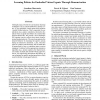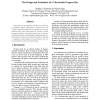66 search results - page 10 / 14 » Bottom-Up Visual Attention for Virtual Human Animation |
IJCAI
2007
13 years 10 months ago
2007
Although many powerful AI and machine learning techniques exist, it remains difficult to quickly create AI for embodied virtual agents that produces visually lifelike behavior. T...
HAPTICS
2005
IEEE
14 years 2 months ago
2005
IEEE
We present an investigation into the use of Tactons to present progress information. Progress bars are common but must compete for screen space and visual attention with other vis...
IVA
2010
Springer
13 years 7 months ago
2010
Springer
Abstract. While interactive virtual humans are becoming widely used in education, training and therapeutic applications, building animations which are both realistic and parameteri...
ETRA
2006
ACM
14 years 2 months ago
2006
ACM
Next-generation immersive virtual environments and video games will require virtual agents with human-like visual attention and gaze behaviors. A critical step is to devise effic...
BCSHCI
2007
13 years 10 months ago
2007
Second Life, a participant-created multi-user virtual environment (MUVE), gained sudden media acclaim in 2006. Prior to that, the world was developing many of the characteristics ...


